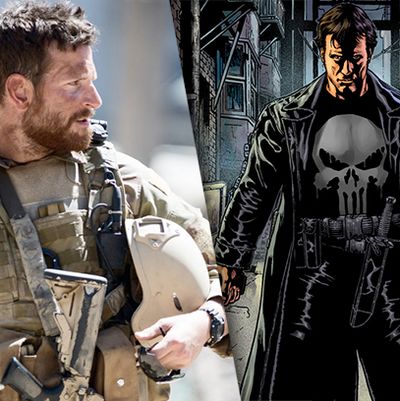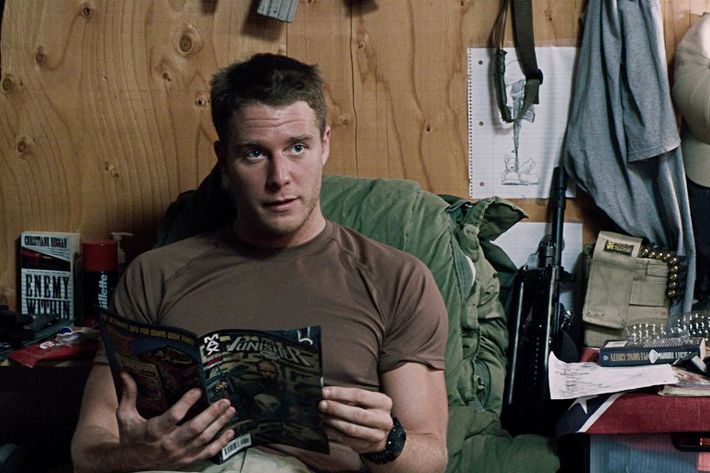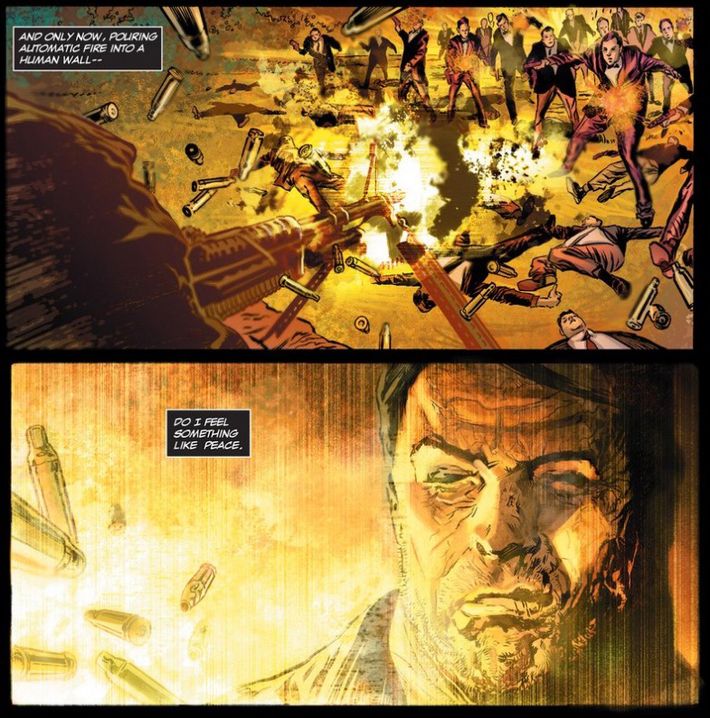
Even American Sniper can’t escape the stranglehold that superhero fiction has on the world’s multiplexes. One of superhero comics’ most potent icons has a subtle but persistent appearance in the movie — as well as a devastatingly memorable appearance in the autobiography that inspired it — and that iconography reveals a lot about the worldview of the fictional and real-life Chris Kyle.
There’s an odd little scene early on in the film where comics abruptly become part of the movie’s universe. Kyle walks into a barracks and finds fellow SEAL Ryan “Biggles” Job sitting on a bed, reading a Punisher comic. Biggles tells Kyle the rest of the troops are out “training those fucking haji soldiers,” but that he bowed out due to a case of “the shits.”
“Readin’ a comic book?” Kyle asks.
“It’s a fucking graphic novel, man,” Biggles replies, pointing a finger. “There’s a big difference.”
Thematically, there’s not much of import in the dialogue (well, other than the fact that Biggles is totally wrong — a short individual issue of an ongoing comics series is a “comic”; a self-contained story published as a longer volume is a “graphic novel”). But the choice of comic is interesting, revealing, and upsetting.

The comic is never named, but if you look closely, you can see that it’s issue No. 1 of the sixth volume of Punisher, released in January of 2004 (making it very believable as something Biggles could be reading during the platoon’s 2004 deployment). The titular Punisher debuted in 1974’s The Amazing Spider-Man No. 129, but he went on to have many series of his own. His core concept is simple: He hates criminals and he murders them with guns. His name is Frank Castle, he became a skilled and haunted soldier in Vietnam. He came back; his family was killed in the crossfire of a mob shooting; and he subsequently dedicated himself to killing the mobsters — and anyone else who he thought deserved to die for his or her actions. His only distinctive trademark is the giant skull logo he wears on his chest.
Although Punisher has often been popular (especially during the late ‘80s and early ‘90s, when the comics industry thrived on grim and gritty antihero action), he’s never been an admirable role model. However, his black-and-white view of who deserves to live and who needs to die fits right in with the moral universe of American Sniper. Kyle’s platoon goes on to call themselves the Punishers and spray-paint the skull logo on their gear, carrying it during their missions to find and execute insurgents. We never get much in the way of explanation about what the Punisher means to the soldiers, but Kyle’s real-life autobiography has a long passage about why he admired the lethal vigilante. It’s a passage that will send a chill down the spine of any antiwar comics fan:
We called ourselves the Punishers.
For those of you who are not familiar with the character, the Punisher debuted in a Marvel comic book series in the 1970s. He’s a real bad-ass who rights wrongs, delivering vigilante justice. A movie by the same name had just come out; the Punisher wore a shirt with a stylized white skull.
Our comms guy suggested it before the deployment. We all thought what the Punisher did was cool: He righted wrongs. He killed bad guys. He made wrongdoers fear him.
That’s what we were all about. So we adapted his symbol— a skull— and made it our own, with some modifications. We spray-painted it on our Hummers and body armor, and our helmets and all our guns. And we spray-painted it on every building or wall we could. We wanted people to know, We’re here and we want to fuck with you.
It was our version of psyops.
You see us? We’re the people kicking your ass. Fear us. Because we will kill you, motherfucker.
You are bad. We are badder. We are bad-ass.
This is, to put it lightly, a very problematic reading of the character. To get a sense of the Punisher’s upsetting worldview, we can turn to the issue that Biggles is reading in the movie. It was written by Northern Irishman Garth Ennis, who is inarguably one of the greatest Punisher writers of all time — and someone with deep ambivalence about the character’s morality and popularity. He’s tended to write Castle as a man who was mentally destroyed during his service in Vietnam (not unlike the version of Chris Kyle we see in American Sniper), and who has become a dangerous psychopath. A stoic psychopath with something resembling a moral compass, but a psychopath nonetheless. He’s way past pursuing justice for what was done to his family — now he just kills people and tells himself he’s doing it for a good reason.
The story in Punisher volume 6, No. 1 is characteristically ultraviolent. Frank makes his way to a mansion where a bunch of mobsters are about to have a party, and on the way, he muses on the warped state of his personal war on evil. He recalls that his family was killed while on a picnic, and that they weren’t even the intended targets — it was some old mobster. “The old man from the park is long since dead; so are his soldiers, so’s the shooter,” Frank thinks to himself. “So are the people who called in the hit, and hundreds, maybe thousands more. But the war goes on.” The overall “why” question doesn’t occur to him.
Frank then opens fire on a crowd of partygoers from the mob get-together. “And only now,” Frank thinks, his face dispassionate, “pouring automatic fire into a human wall — do I feel something like peace.”

It’s hard to imagine reading a story like that and seeing its narrator as a personal icon. Superhero stories are, at their core, larger-than-life allegories about the use of power: who deserves it, what one should do with it, and the consequences of its use. Kyle was, in his own way, a superhero — someone who had abilities with a gun that went far beyond the abilities of anyone else in American military history. American Sniper follows him as he gains and wields it. By painting the Punisher’s skull on himself, the real life and fictional Chris Kyle chose a kind of superhero costume, one that channels a very specific, black-and-white ethos about how to use deadly power. For better or worse, Frank Castle would be proud.

